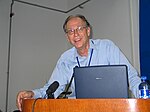Michael S. Waterman
| Michael Spencer Waterman | |
|---|---|

Michael Waterman
|
|
| Born |
June 28, 1942 (age 74) Coquille, Oregon |
| Fields |
Computational Biology Probability and Statistics Computer Science Discrete Mathematics and Combinatorics |
| Institutions | University of Southern California |
| Alma mater |
Oregon State University Michigan State University |
| Thesis | Some Ergodic Properties of Multi-Dimensional F-Expansions (1969) |
| Doctoral advisor | John Rankin Kinney |
| Known for |
Smith-Waterman algorithm Lander-Waterman formula Eulerian De Bruijn sequence assembly |
| Notable awards |
American Academy of Arts and Sciences 1995, Guggenheim Fellowship 1995, US National Academy of Sciences 2001, Gairdner Foundation International Award 2002 French Académie des Sciences 2005 Honorary Doctorate, Tel Aviv University 2011 US National Academy of Engineering 2012 Honorary Doctorate, University of Southern Denmark 2013 Chinese Academy of Sciences 2013 Dan David Prize (2015) |
Professor Michael Spencer Waterman (born June 28, 1942) is a scientist at the University of Southern California (USC), where he holds an Endowed Associates Chair in Biological Sciences, Mathematics and Computer Science. He previously held positions at Los Alamos National Laboratory and Idaho State University. He grew up near Bandon, Oregon and earned a bachelor's degree in Mathematics from Oregon State University, followed by a doctorate in statistics and probability from Michigan State University in 1969.
Waterman is one of the founders and current leaders in the area of computational biology. He focuses on applying mathematics, statistics, and computer science techniques to various problems in molecular biology. His work has contributed to some of the most widely used tools in the field. In particular, the Smith-Waterman algorithm (developed with Temple Smith) is the basis for many sequence comparison programs. In 1988, Waterman and Eric Lander published a landmark paper describing a mathematical model for fingerprint mapping. This work formed one of the theoretical cornerstones for many of the later DNA mapping and sequencing projects, especially the Human Genome Project. A 1995 paper by Idury and Waterman introduced Eulerian-De Bruijn sequence assembly which is widely used in next-generation sequencing projects.
With Istrail and Pevzner, he began the international conference Research in Computational Molecular Biology (RECOMB), and he is a founding editor of the Journal of Computational Biology. He was elected to the American Academy of Art and Sciences in 1995, and elected to the United States National Academy of Sciences in 2001. Since 2005, he is an elected Academician of the French Académie des Sciences. He was elected to the United States National Academy of Engineering in 2012. Waterman also authored one of the earliest textbooks in the field: Introduction to Computational Biology.
...
Wikipedia
